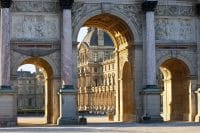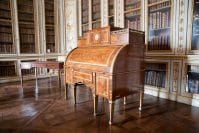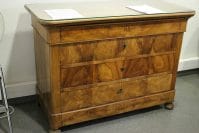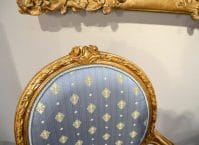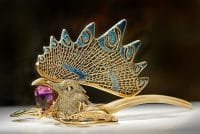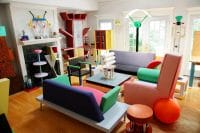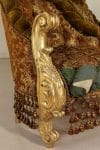The Characteristics of the Louis XVI Style
Started by the Transition style, the return to Antiquity is deepened and defined with the Louis XVI style. The proportions of the volumes are balanced, the elegance is sober and refined: after having abused the curved lines and the asymmetry with the Rococo, we return to straight lines and the simplicity of shapes. The inspiration comes from Greek antiquity, the lines are straight, but nevertheless we try to communicate a certain idea of lightness.
This return to Antiquity coincides with the discovery of the excavations of Pompeii and Herculaneum: which sparked a real craze around 1750 for Greco-Roman architecture and decorations. A large number of books dedicated to Antiquity were published, artists went to Naples to study excavated objects and to draw frescoes; the Pantheon, the ruins, or even the ancient statues preserved by the pope – such as the Apollo of the Belvedere or the Laocoön – become known thanks to the albums.
The archaeologist Winckelmann, unconditional defender of Greek art, which he defined as "noble simplicity and calm grandeur" continues to inspire generations of artists, architects or art theorists, such as Jacques-Louis David, Benjamin West, Lessing, Goeth and Schiller .
In the simplicity and “pastoral” representations of the Louis XVI style one can find his inclination for nature. At the time of the construction of the first cottages, Rousseau wrote La Nouvelle Heloïse (“the New Heloise”) and Bernardin Paul et Virginie (“Paul and Virginia”), two novels of sentimental literature that became sources of inspiration for the decorative arts. The rural aspect of the time is well illustrated by the queen's village near the Palace of Versailles, a miniature and bucolic village, which the king offered to Marie Antoinette in 1782.
Queen Marie Antoinette, through various commissions, plays an important role in the development and diffusion of this style. The "marchand-merciers", at the same time antique dealers and interior decorators, established the link between the rich clients and the artists: it is in their elegant shops in the Louvre or on rue Saint-Honoré that the nobles went to get advice and to renovate your furnishings. The Queen's most recent purchases are displayed in these prestigious galleries, before they are taken to Versailles, so that the wealthier classes could commission similar pieces.
The characteristics of the Louis XVI style
Ancient motifs and a penchant for nature thus come together in architecture, furnishings and furniture: rustic and sentimental symbols combine with rigorous Antiquity, under the influence of the philosophers Rousseau and Diderot. Many ornaments are borrowed from the flora, and this love for nature appears in the decoration through the presence of rose garlands, baskets, palmettes, bows and ribbons inspired by the "taste of nature", sheaves of wheat mixed with meadow flowers, or even some gardening tools, hats of shepherdesses or scythes. These motifs mix with the ancient repertoire in which trophies, Greek friezes, pearl friezes of hearts and hearts, stylized acanthus leaves are found.

Their success depends on the sensitivity of the artist who needed to adapt an idea of antiquity, which would be the source of all perfections, to buildings or furniture from a completely different context.
Mahogany becomes the wood used in the Louis XVI style, in solid or veneer, highly appreciated for its full color due to its fine grain and the variations in the grain, maple, amaranth and yew are the other types of wood used. Jean Delafosse, Riesener, Weisweler, Carlin, Leleu, Saunier and Benneman are some of the talented designers and cabinetmakers who brought this style to its maximum expression in this period.
Ordinary furniture is polished and valuable furniture is inlaid or veneered. The collaboration between Gauthière and Riesener resulted in the harmonious balance between wood and bronzes that would be at the center of the decoration of the time. Sèvres or Wedgwood slabs, rectangular or oval, adorn the secretaires and chests of drawers.
Difference between Louis XVI and Louis XV style
The reign of Louis XV characterized by extreme wealth for the wealthier classes with a monumental distance between the classes. France is the most powerful nation on Earth and, in line with this foreign policy, the rich demanded bigger and better things: More ornate, rarer materials and more intricate carvings than previous styles. The backlash that follows this style finds security in the era of Louis XVI, which turns his interest to classical forms, simplicity of design and reliance on moderation and elegance.
Partly due to the discovery of Pompeii, classical influences of Greek and Roman design supplanted the Asian and Chinese influences of Louis XV. No more carvings of monkeys and other exotic animals, elaborate scrolls, detailed shells and asymmetrical decorations. All this is replaced by classic geometric patterns, symmetrical designs and a notable absence of swirls and long curves.
A big difference between these two furnishing styles is the design of the legs on chairs, sofas and tables. Above all, this is a feature that can be relied on for era identification. The legs of Louis XV furniture they are typically curved in style, often carved with curved designs, and end in a delicate foot. The Louis XVI legs are straight with linear carvings, if present.
The fabric used on Louis XV furniture is mostly floral, particularly in the large floral tapestries of asymmetrical arrangements. Bright colors prevail, often with an overabundance of lace accents or even fur trim. The return to the classical style in the Louis XVI era sees a softening of tapestry colours, intertwined with symmetrical designs and repetition of Greek and Roman geometric designs, such as dental molding and Greek key design.
And mobili
The types of seating are numerous, often less comfortable than under Louis XV, but more refined and harmonious. As often in furniture of this period, the legs take the shape of a column, grooved or spiral, thinner at the base. The back is rectangular or oval and sometimes partially open to represent hot air balloons and baskets.
Come into vogue the cylinder desk, from which the top wraps into the furniture when the desk is opened. The cabinetmaker Riesener, undisputed master of Louis XVI's furniture, made several for the king. Storefronts appeared at that time when art began to be available to more people.
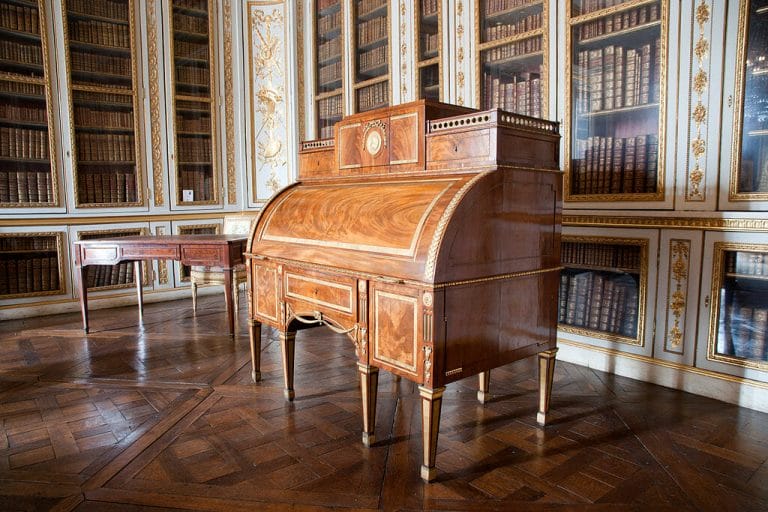
The use of gilded bronze was massive and today this production is one of the most popular of the 18th century. The pendulums, adorned with allegorical characters and with shapes often taken from architecture - obelisks or even triumphal arches - flourished very quickly and decorated the fireplaces. The taste for wallpapers appeared, and the Queen spread them at the Court to brighten up the interiors, under the aegis of the important Reveillon manufacture, which was located in Paris, near the Bastille.
Images
https://commons.wikimedia.org/wiki/File:Salon_Louis_XVI.JPG
Robert Valtte, CC BY-SA 4.0 https://creativecommons.org/licenses/by-sa/4.0, via Wikimedia Commons
https://commons.wikimedia.org/wiki/File:Petit_appartement_du_roi_-Biblioth%C3%A8que_de_Louis_XVI(1) .jpg
Fanny Schertzer, CC BY 3.0 https://creativecommons.org/licenses/by/3.0, via Wikimedia Commons

